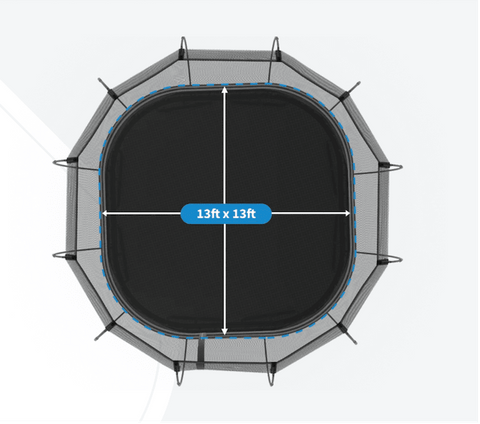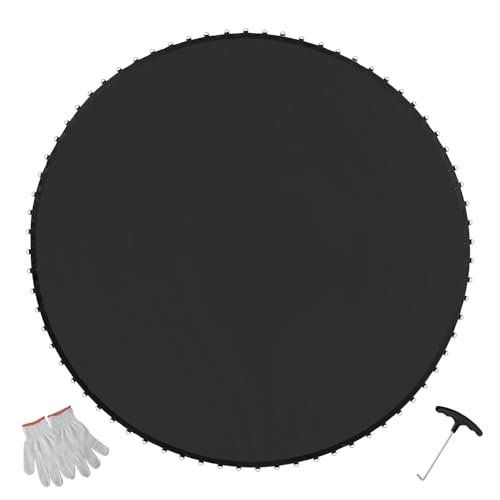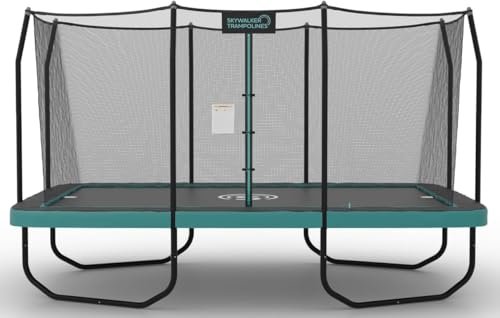Choosing the right trampoline size can feel overwhelming. You want something safe, fun, and perfect for your space.
But how do you know which size fits your needs best? Whether you’re buying for kids, adults, or the whole family, the right trampoline can make all the difference in your outdoor fun. Keep reading, and you’ll discover simple tips to find the perfect trampoline size just for you.

Choosing The Right Trampoline Size
Buying a trampoline means picking the right size for safe fun. Size affects how much space you need and who can use it.
Think about your yard, users, and where you will place the trampoline. This helps find the best fit for your needs.
Consider Available Space
Measure your yard before buying a trampoline. Leave extra room around it for safety and movement.
Smaller yards need smaller trampolines to fit comfortably without crowding your space.
- Check for trees, fences, or buildings near your trampoline area
- Allow at least 3 feet of clearance on all sides
- Remember overhead space for jumping safely
Assess User Age And Weight
Different trampoline sizes suit different ages and weights. Larger trampolines hold more weight and allow more users.
Smaller trampolines are better for young children to keep them safe and comfortable.
| Age Group | Recommended Trampoline Size | Weight Limit |
|---|---|---|
| Toddlers (1-5 years) | 6-8 feet diameter | 100 lbs or less |
| Children (6-12 years) | 8-12 feet diameter | 150-200 lbs |
| Teens and Adults | 12-15 feet diameter or larger | 200 lbs or more |
Indoor Vs Outdoor Use
Indoor trampolines are usually smaller to fit inside a room. Outdoor trampolines can be bigger and more durable.
Outdoor trampolines need weather-resistant materials and strong frames to last in the sun and rain.
- Indoor trampolines: 4-8 feet, light and portable
- Outdoor trampolines: 8-15 feet, sturdy and weatherproof
- Check ceiling height for indoor trampolines
- Use safety nets for outdoor trampolines
Common Trampoline Sizes Explained
Choosing the right trampoline size is important for safety and fun. Trampolines come in many sizes to fit different spaces and needs.
This guide explains small, medium, and large trampolines. You can pick the size that works best for you.
Small Trampolines
Small trampolines usually range from 6 to 8 feet in diameter. They fit well in small yards or indoor spaces.
These trampolines are good for young children or beginners. They take up less space and are easy to move.
- Diameter: 6 to 8 feet
- Best for kids aged 3 to 7 years
- Ideal for small areas and indoors
- Supports 100 to 150 pounds
Medium Trampolines
Medium trampolines are usually 10 to 12 feet wide. They work well for families with children of different ages.
These sizes offer more jumping space and support more weight. They are a good balance between size and safety.
- Diameter: 10 to 12 feet
- Suitable for children 6 years and older
- Supports 150 to 250 pounds
- Fits medium-sized yards
Large Trampolines
Large trampolines start at 14 feet and go up to 16 feet or more. They offer plenty of room for multiple jumpers.
These trampolines are best for big families or outdoor spaces. They support higher weight and allow more active play.
- Diameter: 14 to 16 feet or larger
- Good for teens and adults
- Supports 250 pounds and more
- Needs a large yard for setup
Safety Factors Linked To Size
Choosing the right trampoline size affects safety. It is important to consider space and user limits. This helps prevent injuries and accidents.
Safety depends on more than just size. Proper setup and protection gear also matter. Each factor works together to keep jumpers safe.
Proper Clearance Area
A clearance area around the trampoline lets users jump safely. It stops collisions with walls, trees, or other objects. Size affects how much space is needed.
- Leave at least 6 feet of open space around the trampoline
- Ensure no overhead branches or wires are above
- Use flat and soft ground to reduce injury risk
- Keep the area free from hard objects and sharp edges
Weight Capacity Limits
Trampolines have weight limits based on size and design. Exceeding limits can cause frame damage or falls. Always check the manufacturer’s weight rating before buying.
| Trampoline Size | Max Weight Capacity (lbs) |
| 8 feet | 150 |
| 10 feet | 200 |
| 12 feet | 250 |
| 14 feet | 300 |
| 16 feet | 350 |
Enclosure Nets And Padding
Enclosure nets stop jumpers from falling off the trampoline. Padding covers springs and frames to prevent cuts and bruises. Larger trampolines need stronger and wider safety gear.
Key safety features for enclosure nets and padding:
- High-quality netting that covers the entire jumping area
- Padding that is at least 1 inch thick
- Secure attachment of the net to the frame
- UV-resistant materials to prevent wear and tear
Trampoline Shapes And Their Impact
Choosing the right trampoline shape affects safety and fun. Different shapes change how the trampoline bounces and fits in your space.
Understanding the differences helps you pick the best trampoline size and form for your needs.
Round Trampolines
Round trampolines are the most common shape. They offer a soft bounce that sends jumpers back to the center. This makes them safer for beginners and kids.
- Good for small yards
- Even bounce in all directions
- Lower risk of falling off the edge
- Best for fun and light exercise
Rectangular Trampolines
Rectangular trampolines provide a powerful bounce. They are popular for gymnasts and serious jumpers. The shape gives a larger jumping surface and better bounce control.
| Feature | Round Trampolines | Rectangular Trampolines |
|---|---|---|
| Bounce Type | Soft and centered | Strong and high |
| Jumping Surface | Smaller, rounded | Larger, flat |
| Safety | Higher edge safety | Requires skill to avoid edges |
| Best For | Kids and casual use | Athletes and training |
Octagonal And Other Shapes
Octagonal trampolines blend the benefits of round and rectangular shapes. They offer good bounce space and a safer edge than rectangles.
Other shapes like oval or hexagonal trampolines exist. These shapes fit specific yard spaces or design needs.
- Octagonal: Balanced bounce and space
- Oval: Fits narrow yards
- Hexagonal: Unique shape, moderate bounce
Matching Trampoline Size To Activity
Choosing the right trampoline size depends on the activity you want to enjoy. Different activities need different sizes for safety and fun.
Consider the space you have and the number of users. This will help you find the best fit for your needs.
Casual Bouncing
Casual bouncing is for fun and light exercise. A smaller trampoline works well for kids and small spaces.
- Round trampolines from 8 to 10 feet are good.
- They fit well in backyards and patios.
- Provide enough space for one or two jumpers.
Fitness And Training
Fitness activities need more room to move freely. A larger trampoline helps with exercises like jumping jacks and running in place.
| Trampoline Size | Recommended Use | Users |
|---|---|---|
| 12 to 14 feet | Cardio and balance workouts | 1 person |
| 14 to 16 feet | Group fitness sessions | 2 to 3 people |
Gymnastics And Tricks
For gymnastics and tricks, choose a large, sturdy trampoline. It must have enough space for flips and twists.
Key features for gymnastics trampolines:
- At least 15 feet in diameter
- Strong frame and springs
- Safety nets and padding
- High weight capacity
Budget Considerations For Size
Choosing the right trampoline size affects your budget. Larger trampolines usually cost more.
Think about how much space you have and what you can afford before buying.
Cost Differences By Size
Small trampolines cost less than big ones. The bigger the trampoline, the higher the price.
Extra features like safety nets also add to the cost, especially on larger sizes.
- 6-foot trampolines are usually cheapest
- 10-12 foot trampolines cost more
- 14-16 foot trampolines are the most expensive
Maintenance Expenses
Bigger trampolines need more care. You will spend more on repairs and parts.
Regular checks and cleaning keep your trampoline safe but add to your expenses.
- Large trampolines need bigger replacement parts
- More surface area means more cleaning time
- Safety nets and padding may wear out faster
Value For Money Tips
Buy a trampoline that fits your space and budget well. Avoid paying for extra size you do not need.
Look for durable materials and good warranties to save money on repairs later.
- Choose size based on how many people will use it
- Check customer reviews for durability
- Consider seasonal sales for better prices
Installation And Storage Tips
Choosing the right size trampoline is important for safety and fun. You also need to think about where to place it and how to store it. Proper installation and storage keep the trampoline in good shape.
This guide offers simple tips on space preparation, seasonal storage, and moving your trampoline.
Space Preparation
Pick a flat, open area free of obstacles like trees and fences. The trampoline needs extra space around it for safety.
Clear the ground from rocks, sticks, and anything sharp. Soft grass is best, but you can also use safety mats under the trampoline.
- Choose a flat surface
- Keep at least 3 feet clear space around
- Remove sharp objects nearby
- Use soft ground or safety mats
Seasonal Storage Options
Store your trampoline parts indoors during winter or long breaks. This helps protect the materials from weather damage.
Clean the trampoline before storing. Dry all parts well to stop rust and mold. Use covers if you leave it outside.
- Disassemble if possible for easier storage
- Keep parts dry and clean
- Use waterproof covers outside
- Store in a garage or shed for best protection
Moving And Relocating
Plan your move carefully to avoid damage. Take photos of the trampoline setup to help with reassembly.
Label all parts and keep small pieces in bags. Get help when lifting heavy parts to stay safe.
- Take photos before disassembly
- Label parts clearly
- Keep small pieces in bags
- Lift heavy parts with help
- Reassemble on a flat surface


Frequently Asked Questions
What Size Trampoline Fits Small Backyards Best?
A 6 to 8-foot trampoline suits small backyards. It offers fun without overwhelming limited space. Measure your area before buying to ensure a perfect fit.
How To Choose Trampoline Size For Kids?
For kids, a 8 to 10-foot trampoline is ideal. It provides enough space for safe jumping and play. Smaller sizes limit movement, while larger ones might be unsafe for young children.
What Trampoline Size Is Best For Multiple Users?
A 12 to 15-foot trampoline works well for multiple users. It offers ample space, reducing collision risks. Larger trampolines accommodate friends and family comfortably during group play.
Does Trampoline Size Affect Safety?
Yes, size affects safety. Larger trampolines provide more jumping space, reducing injury risk. Always follow weight limits and safety guidelines regardless of size.
Conclusion
Choosing the right trampoline size is important for safety. Consider your yard space and user’s age. Larger trampolines offer more bounce room. Smaller ones fit tight spaces better. Always prioritize safety features. Check weight limits for a safer experience. Measure your available space before buying.
Remember, a trampoline should fit your lifestyle and needs. With the right size, enjoy fun and fitness. Make your decision wisely for years of enjoyment. Your perfect trampoline awaits, ready to bring joy and excitement. Happy bouncing!



